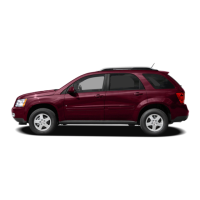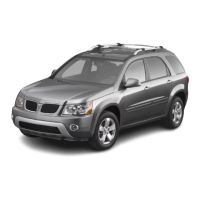Do you have a question about the Pontiac 2009 Torrent and is the answer not in the manual?
Covers manual and power adjustments for front seats, including height and lumbar.
Details split folding rear seat functionality and child restraint compatibility.
Explains the importance, function, and proper use of safety belts for all occupants.
Details proper use of vehicle safety belts for older children and considerations for infants.
Explains the types of airbags, their locations, and how they function as supplemental restraints.
Outlines how to check safety belts and airbag systems for proper function and damage.
Covers ignition use, bar-coded key tags, and lockout assistance.
Explains the operation, range, and troubleshooting for the RKE system.
Details manual and power door locks, delayed locking, and rear door security features.
Discusses power windows, express-down features, and window lockout controls for safety.
Covers content theft-deterrent alarm and PASS-Key® III+ electronic immobilizer operation.
Provides guidance on new vehicle break-in, ignition positions, and starting the engine.
Explains the adjustment and features of manual and automatic dimming rearview mirrors.
Details how to adjust outside power mirrors using controls on the instrument panel.
Explains the function of convex mirrors and potential hazards due to altered depth perception.
Introduces OnStar services for safety, security, information, and convenience.
Describes interior storage locations like glove box, cupholders, and center console.
Provides instructions and cautions for using the vehicle's luggage carrier and crossrails.
Explains how to adjust the rear cargo panel/cover into different positions for storage.
Details how to set up the adjustable panel as a table and its weight limitations.
Describes the use of the rear convenience net for storing small loads.
Explains how to operate the sunroof, including express-open and vent positions.
Provides a labeled diagram of the main components of the instrument panel.
Explains how to activate hazard warning flashers to alert other drivers.
Briefly describes how to sound the horn using steering wheel controls.
Details how to adjust the steering wheel's position for comfort and control.
Covers operation of turn signals and lane-change signals.
Explains how to switch between low and high beam headlamps and flash-to-pass.
Describes the operation of windshield wipers, including speed and delay adjustments.
Explains how to use the windshield washer fluid and cautions regarding freezing weather.
Details the operation of the rear window wiper and washer.
Explains how cruise control works, its limitations, and safety precautions.
Provides step-by-step instructions on how to set, resume, and cancel cruise control speeds.
Covers exterior lamp control positions: AUTO, Parking Lamps, and Headlamps.
Explains the function of Daytime Running Lamps (DRL) for visibility during daylight.
Describes how the automatic headlamp system operates based on ambient light conditions.
Details the use of fog lamps for improved visibility in foggy or misty conditions.
Explains how to adjust the brightness of the instrument panel lights.
Describes the settings for the dome lamp: off, door-activated, or on.
Explains how interior and cargo lamps operate upon door opening or RKE unlock.
Briefly describes how to turn map lamps on and off.
Notes the location and control of the cargo lamp.
Explains the vehicle's system for managing battery charge and voltage.
Details features designed to prevent battery drain from interior lamps and retained accessories.
Covers the use and limitations of accessory power outlets for connecting electrical devices.
Describes the removable ashtray and the cigarette lighter's operation.
Explains how to control the vehicle's heating, cooling, and ventilation system.
Describes how to adjust air louvers for directing airflow.
Explains the function of the air filter and how to replace it.
Introduces warning lights and gages as signals for vehicle functions and potential problems.
Provides an overview of the instrument panel cluster and its gauges.
Explains the function of the speedometer and odometer for tracking speed and distance.
Describes the trip odometer's location and reset function within the DIC.
Explains the tachometer's function in displaying engine speed in revolutions per minute (RPM).
Covers the chime and light indicators for driver and passenger safety belt usage.
Explains the airbag readiness light's function in indicating system status and potential malfunctions.
Details the indicator for the passenger sensing system and airbag status (ON/OFF).
Explains the charging system light and potential issues with the generator or battery.
Covers the brake system warning light indicating a problem with the hydraulic brake system.
Explains the ABS warning light and its behavior during normal operation and system issues.
Describes the TCS warning light, its function during wheel spin, and when the system is active or off.
Explains the engine coolant temperature warning light and actions to take when the engine overheats.
Details how the engine coolant temperature gage works and what indicates overheating.
Covers the tire pressure light and its indication of underinflated tires.
Explains the check engine light (OBD II system) and its meaning for emissions and engine performance.
Describes the oil pressure light and the critical importance of low oil pressure.
Explains the engine oil change reminder light and associated DIC messages.
Provides information about the security light and vehicle security systems.
Notes when the fog lamp indicator light is illuminated.
Explains when the cruise control indicator light turns on and off.
Describes the reduced engine power light and its implications for vehicle performance.
Indicates when the high-beam headlamps are in use.
Explains the service light for the AWD system indicating a potential problem.
Covers the light indicating the rear drive system is overheating.
Discusses electric power steering systems and potential issues affecting steering effort.
Indicates when the liftgate is not completely closed.
Indicates when a door is open and requires checking closure.
Alerts the driver to conditions requiring vehicle service for non-emissions issues.
Explains how the fuel gauge indicates the remaining fuel level in the tank.
Covers the low fuel warning light and associated DIC messages.
Introduces the DIC display for messages, trip, fuel, and system information.
Details how to access and navigate various displays within the DIC using its buttons.
Explains how to calibrate and set the compass zone for accurate directional readings.
Lists possible DIC messages and their meanings, providing guidance for driver action.
Explains various messages displayed by the XM radio system and their implications.
Covers the use of Bluetooth for hands-free phone calls and voice commands.
Details how voice recognition works for commands and the importance of minimizing background noise.
Explains how audio output works with Bluetooth and the function of the volume knob.
Describes steering wheel buttons for operating the Bluetooth system, including call handling.
Outlines the process of pairing a Bluetooth phone with the vehicle's system.
Provides step-by-step instructions for pairing a cell phone with the vehicle's Bluetooth system.
Explains how to store phone numbers as name tags for easier retrieval and dialing.
Details how to store phone numbers by entering digits individually for the Bluetooth system.
Describes how to access and use the directory of stored name tags in the Bluetooth system.
Lists the voice commands available for making calls through the Bluetooth system.
Explains how to use the "Dial" command to place calls using voice recognition.
Details how to place calls by speaking digits individually via voice recognition.
Explains how to use the "Call" command to place calls by speaking stored name tags.
Describes how to use the "Re-dial" command to call the last number dialed.
Explains how incoming calls are handled by the audio system and voice commands to answer or ignore.
Covers managing call waiting and switching between calls using Bluetooth commands.
Details the process for initiating and managing three-way calls via Bluetooth.
Briefly explains how to end a call.
Describes how to mute audio during a call so the other party cannot hear.
Explains how to transfer audio between the phone and the vehicle's Bluetooth system.
Introduces the RSE system, including DVD player, screen, and audio/video jacks.
Explains the Parental Control feature for the RSE system and how to enable/disable it.
Covers the use, care, and battery replacement for the wireless headphones.
Describes the location and color coding of the A/V jacks for connecting auxiliary devices.
Explains the possible sources for audio output, including headphones and vehicle speakers.
Details how to adjust RSE video screen settings like mode, brightness, and language.
Explains how to use and position the video screen located in the overhead console.
Provides instructions on using the remote control for the RSE system and potential issues.
Details the functions of various buttons on the remote control for the RSE system.
Explains the display buttons and tags used for DVD playback on the radio.
Lists common DVD radio error messages and their potential causes.
Discusses potential causes of video distortion when using electronic devices near the vehicle.
Describes how to adjust audio system functions using controls on the steering wheel.
Discusses factors affecting radio reception, such as interference and static.
Introduces XM Satellite Radio service, its coverage, and subscription details.
Explains how cellular phone usage can interfere with the vehicle's radio reception.
Notes the location of the multi-band antenna and its function for AM/FM, OnStar, and XM.
Provides tips for better fuel economy and emphasizes defensive driving techniques.
Highlights the dangers of drinking and driving, its effects on reflexes, and legal implications.
Explains how brakes, steering, and accelerator systems work together to control the vehicle.
Covers braking action, perception/reaction time, and factors affecting stopping distance.
Describes the ABS system, its function in preventing skids, and proper usage.
Explains how ABS aids in steering and braking during emergency maneuvers.
Details the StabiliTrak system for maintaining directional control and its warning indicators.
Explains the TCS function for limiting wheel spin and its operation in slippery conditions.
Describes how the AWD system operates automatically for traction and its service indicators.
Discusses electric power steering systems and potential issues affecting steering effort.
Provides guidance on using steering effectively for evasive maneuvers during emergencies.
Offers advice on recovering the vehicle if its wheels drop off the pavement edge.
Gives tips for safely passing other vehicles, especially on two-lane roads.
Explains what happens when vehicle control is lost due to insufficient tire friction.
Details how skids occur and how to handle braking, steering, and acceleration skids.
Provides tips for safer night driving, including visibility and driver impairment.
Offers advice for driving in wet conditions, including hydroplaning and brake care.
Explains the phenomenon of hydroplaning and the importance of reducing speed on wet roads.
Lists essential vehicle checks and preparations recommended before embarking on a long trip.
Warns about highway hypnosis and provides tips for staying alert while driving long distances.
Gives advice for driving on steep hills and mountain roads, including gear selection and overheating prevention.
Provides guidance for driving safely in snow and ice conditions, including traction control use.
Offers safety tips for being stuck in snow, including hazard flashers and exhaust safety.
Explains how to free a stuck vehicle using the rocking method and traction systems.
Details the process of rocking the vehicle to free it from being stuck.
Explains how to determine correct load limits and cautions against overloading.
Describes the tire and loading information label, its components, and location.
Provides a step-by-step method to calculate the vehicle's correct load capacity.
Explains the certification label which shows tire size and weight ratings.
Introduces towing concepts and important considerations before recreational vehicle towing.
Advises on proper procedures for towing a disabled vehicle.
Explains types of recreational towing like dinghy and dolly towing.
Details procedures for dinghy towing vehicles with a 5-speed transmission.
Outlines procedures for dinghy towing vehicles with a 6-speed transmission.
Provides steps for dolly towing a front-wheel-drive vehicle with a 5-speed transmission.
Explains that AWD vehicles cannot be dolly towed with wheels on the ground.
Details steps for dolly towing a front-wheel-drive vehicle with a 6-speed transmission.
Warns against towing vehicles from the rear due to potential damage.
Offers essential tips and safety rules for towing a trailer, emphasizing correct equipment and safe practices.
Provides important points regarding trailer laws, speed limits, and vehicle preparation for towing.
Explains how trailer weight affects vehicle capacity and the importance of proper tongue weight.
Stresses the importance of proper tire inflation and avoiding overloading.
Discusses the importance of correct hitch equipment and proper installation.
Explains the proper use and attachment of safety chains when towing.
Covers the requirement for trailer brakes on heavier trailers and cautions against interfering with the vehicle's brake system.
Offers advice for driving with a trailer, including checking equipment and handling the vehicle's extended length.
Explains how the Electronic Trailer Sway Control feature detects and helps manage trailer sway.
Emphasizes maintaining a safe following distance when towing a trailer.
Highlights the need for increased passing distance when towing a trailer.
Provides tips for backing up safely with a trailer, emphasizing slow movements and guidance.
Advises on making wider turns when trailering to avoid vehicle or trailer contact.
Explains how trailer lamps function with turn signals and the importance of checking trailer bulbs.
Gives recommendations for driving on steep hills and grades, including gear selection and overheating prevention.
Provides critical safety steps for parking on hills with a trailer attached.
Details the steps to take after parking on a hill before driving away.
Outlines increased maintenance needs when towing a trailer, focusing on key fluids and systems.
Addresses potential engine overheating during trailer towing and related precautions.
Guides users on obtaining service and parts from GM dealers/retailers, emphasizing genuine parts.
Warns about how aftermarket accessories can affect vehicle performance, safety, and warranty.
Provides a warning about chemicals found in motor vehicles as per California law.
Mentions special handling for perchlorate materials found in certain automotive applications.
Offers cautions and advice for individuals performing their own vehicle maintenance.
Discusses how external additions can affect airflow, noise, and performance.
Covers essential fuel information, including octane, specifications, and additives.
Explains octane requirements for different engines and the effects of using lower octane fuel.
Details minimum gasoline specifications and recommends against MMT additives.
Addresses fuel requirements for vehicles certified to meet California Emissions Standards.
Discusses fuel additives and recommends TOP TIER Detergent Gasoline and GM Fuel System Treatment PLUS.
Provides critical safety instructions and procedures for refueling the vehicle.
Gives safety precautions for filling portable fuel containers to prevent static discharge and fire.
Offers general cautions about working under the hood, especially regarding electric fans and hot engine parts.
Details the steps for opening the vehicle's hood.
Provides a visual guide to the components located in the engine compartment for the 3.4L V6 engine.
Covers checking engine oil levels, the dipstick, and when to add oil.
Explains how to check the oil level using the dipstick and how much oil to add.
Specifies the recommended engine oil type, viscosity grade, and API starburst symbol.
Advises against using oil additives and engine oil flushes, recommending only standard oils.
Explains the system that indicates when to change engine oil based on usage, not mileage.
Provides instructions on how to reset the engine oil life system after an oil change.
Details the location of the air cleaner/filter and when to inspect or replace it.
Covers transmission fluid level checks, recommended service intervals, and fluid types.
Explains the function of the cooling system, including cooling fans and coolant surge tank.
Details the type of engine coolant used, its lifespan, and how to check its level.
Advises on the correct coolant mixture and cautions against using plain water or improper mixtures.
Provides instructions for checking the coolant level in the surge tank under various temperature conditions.
Guides on safely adding coolant to the surge tank, including cautions about hot engine parts.
Explains the indicators of engine overheating and immediate actions to take.
Covers checking power steering fluid levels and when it is necessary for vehicles with hydraulic systems.
Details what to use for windshield washer fluid and how to add it, including freezing precautions.
Discusses brake fluid level checks, reasons for fluid loss, and the brake warning light.
Explains how to identify worn brake pads through warning sounds and the importance of timely replacement.
Provides information on battery types, replacement, and cautions related to battery acid and gas.
Offers advice on vehicle storage, including battery maintenance for infrequent or extended use.
Details safe procedures for jump starting a vehicle using jumper cables and another vehicle's battery.
Advises on performing lubricant checks for the all-wheel-drive system.
Covers when to check lubricant for the transfer case and how to perform the check.
Explains when to check and change lubricant for the rear drive module.
Discusses headlamp aim adjustment, typically preset, and when professional service might be needed.
Directs users to replacement bulb information and advises contacting dealers for unlisted procedures.
Includes a caution about the pressurized gas inside halogen bulbs and the importance of following package instructions.
Provides instructions for replacing bulbs in the headlamp, turn signal, sidemarker, and parking lamps.
Details the steps for replacing bulbs in the taillamp assemblies.
Explains how to replace the license plate lamp bulbs.
Lists common exterior lamp bulb numbers and advises contacting dealers for unlisted parts.
Guides on inspecting and replacing windshield and rear window wiper blades.
Covers tire maintenance, safety, and when new tires are needed, emphasizing proper care.
Explains the information molded into tire sidewalls, including size, DOT codes, and ply material.
Describes the UTQG system for grading tires based on treadwear, traction, and temperature.
Discusses the importance of proper wheel alignment and tire balance for optimal performance and tire life.
Advises on when to replace wheels and the importance of using correct GM original equipment parts.
Warns against using tire chains due to clearance issues and potential damage.
Provides guidance on what to expect and how to react if a tire blows out or loses air.
Details the safe procedure for changing a flat tire, including using the jack and hazard flashers.
Explains how to access and remove the spare tire and tools from the rear compartment.
Guides on loosening wheel nuts, removing the flat tire, and installing the spare.
Provides instructions for properly storing the flat tire, spare tire, and tools.
Covers the use, limitations, and maintenance of the compact spare tire.
Emphasizes the importance of engine oil level and timely changes.
Stresses the necessity of following scheduled maintenance for vehicle condition and warranty.
Highlights how proper maintenance contributes to vehicle condition and environmental protection.
Guides the user on how to use the maintenance schedule based on driving habits and conditions.
Details the recommended service intervals for oil changes based on the oil life system.
Lists services required at specific mileage or time intervals, including footnotes for details.
Outlines owner-performed checks and services recommended at each fuel fill and monthly intervals.
Lists important underhood checks to perform every time the vehicle is refueled.
Stresses the importance of checking engine oil regularly to prevent damage.
Details monthly checks, including tire inflation and inspection for wear or damage.
Explains how to check tire pressure when tires are cold and the importance of correct inflation.
Advises on inspecting tires for wear and rotation needs, especially for high-mileage drivers.
Covers annual checks, specifically the starter switch and ignition transmission lock system.
Provides a safety check procedure for the starter switch and gear selection.
Details a safety check for the shift lock control system to ensure proper parking engagement.
Outlines how to check the ignition lock's functionality in different shift lever positions.
Explains checks for the parking brake and automatic transmission's park mechanism safety.
Lists specific fluids and lubricants recommended for the vehicle, including part numbers.
Outlines a step-by-step process for resolving customer concerns with dealerships.
Introduces the online owner center for vehicle information, service records, and dealer lookup.
Provides contact information for TTY users needing assistance.
Lists contact details for customer assistance offices in the US, Canada, Mexico, and Caribbean.
Describes a program that reimburses costs for eligible aftermarket adaptive equipment.
Details the services provided by roadside assistance, including fuel delivery, lock-out, and towing.
Advises on how to schedule service appointments and communicate transportation needs.
Explains courtesy transportation options available during warranty repairs to minimize inconvenience.
Emphasizes the importance of using qualified technicians and proper parts for collision repairs.
Discusses genuine GM collision parts versus recycled parts and their impact on warranty and performance.
Recommends choosing a collision repair facility with GM-trained technicians and proper equipment.
Advises on selecting insurance coverage that prioritizes GM original equipment parts for repairs.
Provides essential steps to take if involved in a crash, including checking for injuries and gathering information.
Guides owners on actively managing the vehicle damage repair process, emphasizing part choices.
Explains how to report safety defects to government agencies and General Motors.
Details the process for reporting safety defects to NHTSA, including contact information.
Outlines how to report safety defects to Transport Canada and General Motors of Canada.
Instructs users to notify General Motors about safety defects, providing contact information.
Provides details on how to order service manuals and bulletins for vehicle maintenance.
Explains how GM vehicles record performance data and discusses privacy considerations.
Describes the function of Event Data Recorders (EDR) in capturing crash-related data for analysis.
Provides information on OnStar services, data collection, and subscription terms.
Covers storage of navigation data like destinations and addresses within the system.
Explains the use of RFID technology in vehicles for functions like tire monitoring and security.
| Brand | Pontiac |
|---|---|
| Model | 2009 Torrent |
| Category | Automobile |
| Language | English |












